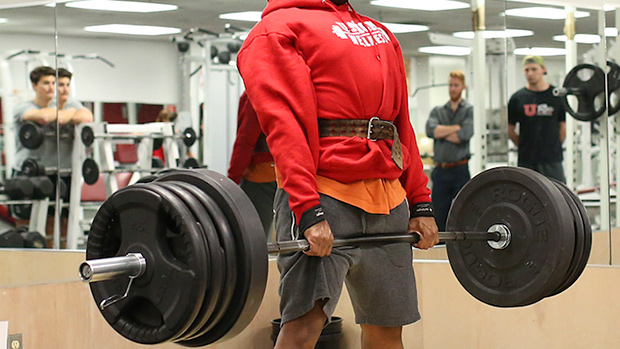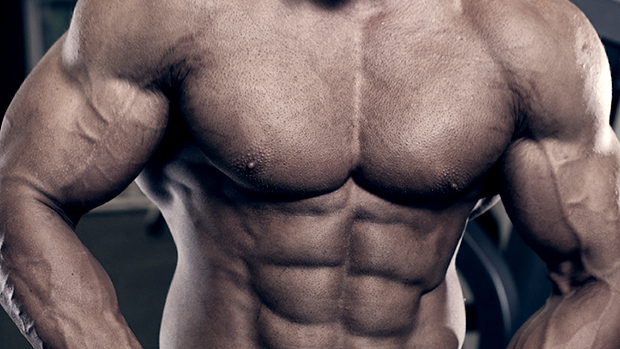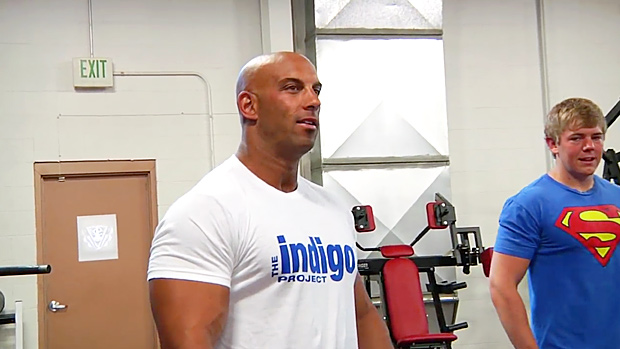Truth be told, there isn't much that I can legitimately claim to be an expert on, Star Wars notwithstanding. One rare exception is the deadlift. While not Andy Bolton-esque by any stretch, my 570-pound pull at a (then) bodyweight of 190 pounds allows me some bragging rights.
I consider the deadlift the ultimate showcase of overall strength. The entire body has to work in unison to accomplish the task at hand, and unlike the squat or bench press (where it's much easier to cheat), there's no debating the deadlift. Either the bar comes off the ground and you lock it out, or it doesn't, and you have to hand in your man card.
While I've written extensively on the deadlift in the past, I still have more to say. Let's see if the following random thoughts help you finally achieve deadlifting badassery.
Thoughts On the Setup
Without question, the setup makes or breaks the deadlift. If you're lazy and just go through the motions, you'll fail miserably, or worse, get hurt. Conversely, if you check your ego at the door and take the time to setup correctly, more often than not, you'll be rewarded with a bigger lift.
On several occasions I've noted that one should retract (pull together) their shoulder blades when setting up for the pull. This stiffens the mid-back, engages the lats (which in turn provides more spinal stability), and activates the thoraco-lumbar fascia, which helps to better transfer force from the lower body to the upper body.
Based on feedback in the LiveSpill as well as various emails I've received, this whole "retraction" thing has confused more people than Chaz Bono in a men's room.
As such, while I still feel that stiffening the upper back and activating the lats is integral for improving the deadlift, I've modified my approach. Slightly.
Trying to actively pinch the shoulder blades together while deadlifting just feels awkward. But when I use the phrase, "lock your shoulder blades into place and think about putting them in your back pocket," it's like magic, and people get it.
As a result, many of the benefits that I described above come into play. You shorten the lever arm length from the shoulder to the lumbar spine, and you also engage the lats to help protect the lumbar spine and the SI joint. But as a general observation, the pull just "feels" stronger.
Try it out on your next deadlifting day. I can almost guarantee you'll notice an improvement.
Packing the Neck

Possibly more important for a healthy, powerful, deadlift is packing the neck as opposed to hyperextending it, which is a big no-no for several reasons.
- Hyperextending the neck isn't safe. We've got one spine, and whatever happens in the neck will, concurrently, mirror itself in the lumbar spine. We wouldn't allow someone to deadlift with a hyper-lordotic lower back, so it stands to reason that we shouldn't allow hyper-lordosis in the cervical area, either.
- Respected trainer and therapist Charlie Weingroff also notes, "Spinal stabilization is and always will be the name of the game when it comes to pulling big weight. It's no coincidence that the positions of integrity are also the positions that lend themselves to improved performance."
Don't believe me? Try this little experiment. Stand tall against a wall and pack your neck (make a double chin) making sure to "wiggle" your head high into position.
Now, have someone shove you. You probably didn't budge.
Alternatively, do the same thing but relax your neck, and maybe extend it a little (look up). Have someone nudge again. You should've noticed a big difference.
If you're weaker when the neck is extending while standing, how is this any different than when doing a deadlift?
So to reiterate, when deadlifting, pack your neck. While this rule may not be quite as easy to follow during max effort attempts, I'd be remiss not to show that it IS possible.
To summarize, let's break this down into list format:
- When you set up, grab the bar and "pull" yourself into position by "locking" your shoulder blades into place and actively keeping them depressed, i.e., in your back pocket.
- Additionally, and to add onto the point above, think "chest tall, hips down, and arch your back!"
- When in position, pack your neck. Again, if you can see the wall in front of you, you're not doing it right. Alternatively, if you look down at a point that's roughly 10-15 feet in front of you, and keep your eyes fixated on that point, you're golden.
- If you're wearing gloves, stop it. Now. Seriously.
Thoughts on Weak Points
When it comes to deadlifting, trainees tend to fall into one of two camps: those who miss off the floor, and those who miss at lockout.
If you miss at the bottom:
- This could be the Captain Obvious in me speaking , but you have too much weight on the bar. Take some plates off, tough guy.
- Get your lats activated. See above. I'm telling you, it works. The only way you're going to find out is by giving it a try.
- You're slower than molasses and need some dedicated speed work to help plow through your sticking point and get the bar off the ground with more force. Getting faster will undoubtedly help with getting you stronger, which is why powerlifters often incorporate "speed" days (dynamic effort) during their training week.
- In short, by using roughly 50-65% of your 1RM, you're going to concentrate on bar speed, which will help with ripping the bar off the floor with a little more "giddy up."
- Moreover, another (and less commonly used) strategy would be to make the movement more challenging by increasing the range of motion. By standing on some blocks or plates you'll make the movement harder and force your body to improve leg and hip drive. Do this for a few weeks and I guarantee when you revert back to traditional pulling, it will feel infinitely easier.
- Along similar lines, you could also include more snatch grip pulls into the mix as the widened grip increases the range of motion.
- Lastly, try some Anderson half squats, a favorite of fellow T Nation contributor and ass-Jedi Bret Contreras. Yes, I just used the words half and squat in the same sentence. Hear me out.
Any movement that emulates the starting position of the deadlift will likely transfer well to the deadlift. What's more, and this is something that many trainees fail to recognize, the quads do play a significant role in the lift, especially in the starting position. Anderson half squats are an awesome movement that will help produce more leg drive off the floor, translating into a bigger, more efficient pull.
One piece of advice, however. Make sure that you share the load properly between the hip and knee joints. If you let the knees jut forward than it probably won't transfer much to the deadlift. Remember to sit back.
If you miss at the top:
- For those who tend to miss their pulls at or near knee level and can't seem to lock it out, some dedicated speed work implementing accommodating resistance (chains or bands) would be in order.
- Using chains as an example, the premise here is simple. The bar is "deloaded" at the bottom, and "loaded" as you get closer to lockout. Because the bar is deloaded near the floor, you're now able to generate some bar speed, which will then help you explode through the sticking point at or near the top half of the lift.
- Rack pulls. I'm not convinced that rack pulls translate well to the deadlift. As noted above, much of what makes speed work with accommodating resistance so beneficial is that you're emphasizing bar speed, and working your way through a sticking point.
In fact, some studies state that there's only a 15 to 20 degree carry over. Significant, yes, but definitely not ideal when you're trying to improve a lift that starts from the ground.
That said, if you want to do rack pulls, do rack pulls. For some, it's a psychological boost, and there 's something to be said about "feeling" what it's like to locking out a heavier weight. Nonetheless, if you go this route, make sure you replicate the same kinematics as the top portion of your deadlift, meaning that the rack pull will almost look like a Romanian deadlift, not a partial squat.
- For the most part, your time would be better spent focusing on accessory work that hammers the muscles most involved with your lockout, namely the hamstrings and glutes. Good mornings are #1 on my list of "go to" money exercises to increase the deadlift. Some other ones would be barbell hip thrusters, kettlebell swings, and glute ham raises.
Miscellaneous Miscellany
In closing, here are some other random bits of awesomeness to kick up your deadlift.
- For the love of all that's holy, take off your shoes. If you train at a gym that forbids barefoot training, at the very least, get yourself a pair of Chuck Taylors or New Balance Minimus.
- Slow down. When performing multiple reps of deadlifts, think of each rep as it's own set.
This works really well with clients when trying to clean up their technique. There's no law against pausing on the floor between each rep to "gather" yourself, get your air, re-establish a good back position, activate the lats, and perform a crisp rep.
Slow down. Gather yourself between each rep, and do it right!
- Back off with the high reps. I rarely program more than 5-6 reps with deadlifts. Anything more than that can technically be considered cardio, and more to the point, technique often suffers. So, while you think your sets of 20 with 225 lbs is 2 legit 2 quit, I think it's retarded. And your spine hates you.
For most, using the 5x5 approach to take your deadlift from the 200+ lb range to the 300+ lb range will work brilliantly. It's progressive overload at it's finest, and it works. However, if you're attempting to enter "big boy" status and pull in the 400+ or even 500+ range, 5x5 ain't gonna cut it. Sorry.
I'd go so far as to say that you'd be hard pressed to ever get to the really big weights using the 5x5 protocol, and if you do, it will take forever!
On the other hand, if you're already pulling in the 300+ lb range, I'd suggest adding in more pulls at or above 90% of your 1RM.
Getting stronger is really about making the CNS more efficient. Sadly, you're not going to accomplish this by performing 5x5 till you're blue in the face. Conversely, it's well established that using loads at or slightly above 90% of one's 1RM affects the following:
- Maximum number of motor units (MUs) are recruited.
- Fastest MU's are activated.
- The discharge frequency (rate coding) is increased.
- Activity is synchronous.
- Improved coordination between synergistic muscles.
- Potential for future hypertrophy gains.
- Increased serum Testosterone levels.
- Spontaneously impregnate every female within a two-block radius.
So the only question left to answer is, what would a typical training session look like?
Lets say your goal is to hit FOUR sets at or above 90% of your 1RM. You know going in that your previous best deadlift is 405 lbs. If that's the case, 90% of 405 lbs is 365 lbs.
So it may look something like this:
- 135 x 5
- 225 x 5
- 315 x 3
- 365 x 1
- 385 x 1 – was a little bit of a grinder, but you feel good and decide to match your PR.
- 405 x 1 – that's about all you have for the day. Remember, the goal here isn't necessarily to break a PR (although, that would be cool), but rather, to hit a certain number of sets at or above 90%. In this case, 90% of 405 lbs is 365 lbs. so any lift at or above this number "counts" as a set. In this case you've already performed THREE sets, so you have one more to complete.
- 385 x 1 – you decide to drop the weight a bit, focus on some bar speed, and dominate it. Congratulations.
Lastly, if anyone comes up to you and says something like "I heard that deadlifts were bad for your back," you have my permission to scissor kick them in the face.
I'm done. Go. Deadlift Your Ass Off.





